Columns of Product Composition |
  
|
The Columns tab of the of the ![]() Product Composition Parameters and
Product Composition Parameters and ![]() Product Composition Types windows contains the list of product composition's columns. Default product composition contains standard set of BoM columns. You can add new columns, delete existing ones or edit their properties.
Product Composition Types windows contains the list of product composition's columns. Default product composition contains standard set of BoM columns. You can add new columns, delete existing ones or edit their properties.
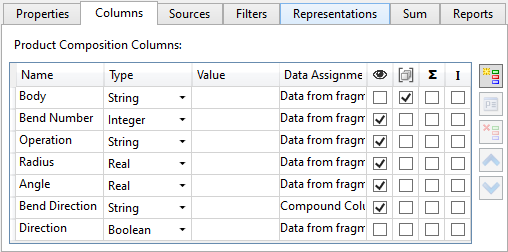
Each entry of the list represents a particular column of product composition. Entries can be selected using ![]() . Following buttons are located at the right side of the list:
. Following buttons are located at the right side of the list:
![]() Add <Ctrl>+<N>
Add <Ctrl>+<N>
Creates a new entry and invokes its properties dialog. A new entry will be placed in the list after the currently selected entry. If no entries are selected, a new entry will be placed last in the list.
![]() Properties <F4>
Properties <F4>
Invokes properties dialog of a selected entry.
![]() Delete <Del>
Delete <Del>
Deletes a selected entry.
![]() Up and
Up and ![]() Down
Down
Move a selected entry up or down the list.
Following properties are displayed for each entry in the list:
•Name
•Type
![]() Show column in Product Composition window
Show column in Product Composition window
![]() Group records by column in Product Composition window
Group records by column in Product Composition window
![]() Sum values when merging records
Sum values when merging records
![]() Ignore parameter when comparing records to merge
Ignore parameter when comparing records to merge
These properties (except Data Assignment) can be edited directly in the list without invoking a column's properties dialog. The dialog contains full set of column's properties and can be invoked using the ![]() Properties button.
Properties button.
Clicking ![]() a header of column's list sorts the list by the corresponding property. Upon first click, entries are sorted in ascending order, upon second click - in descending order. You can Cancel Sorting using a contextual menu of any entry. The same menu contains commands mentioned above, as well as commands for copying entries via clipboard.
a header of column's list sorts the list by the corresponding property. Upon first click, entries are sorted in ascending order, upon second click - in descending order. You can Cancel Sorting using a contextual menu of any entry. The same menu contains commands mentioned above, as well as commands for copying entries via clipboard.
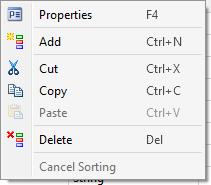
The Column Properties dialog contains following groups of parameters:
•Number format (presence and content of this group depends on column's data type)
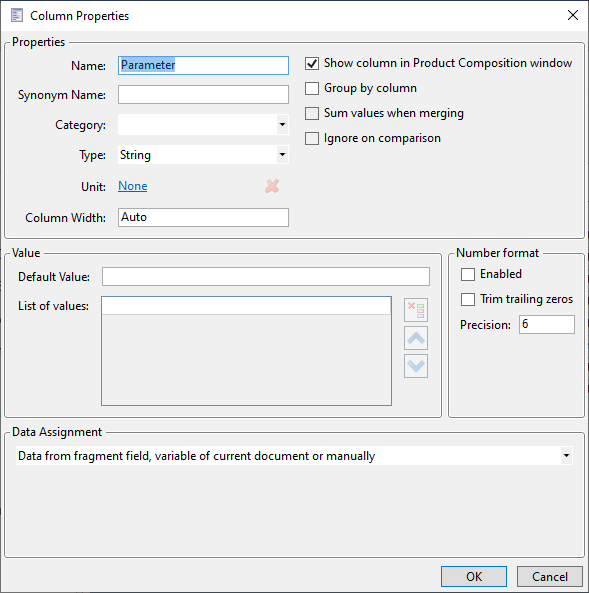
Properties
The group contains following properties:
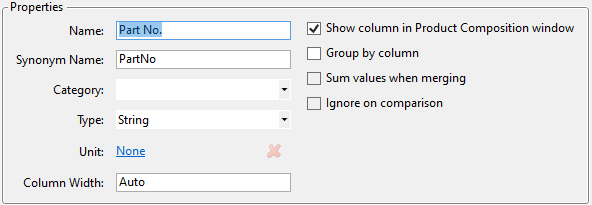
Synonym Name
Simpler name that can be used in the report template. It is recommended to specify a synonym without spaces. For example, if properties are set as in the picture above, you can write {PartNo/} in a template instead of {param name = "Part No."/}.
Category
Columns can be grouped into categories. Categories are used for grouping properties in the record parameters window and in the header’s contextual menu within the ![]() Product Composition window.
Product Composition window.
The Inclusion Data category is reserved for the system columns “Include in Report/BOM of current document”, “Include in assembly” and “Position”. If the column has no category, it will be placed to the Main Data category.
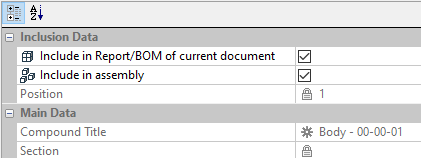
You can type in a category name via keyboard or select it from the drop-down list. When you enter a new category name, it is added to the list.

Type
Parameter sets type of data in the column:

•Boolean
The value is used as a toggle. If the column field is linked with a variable, then the “0” variable value switches the field off (value “False”), other values switch the field on (value “True”).
•Integer
The column contains integer numbers. When the real number is entered into the column, its fractional part will be omitted.
•Real
The column contains real values.
•String
The column contains text string.
Number format can be customized for Real and String data types.
Unit
Unit of measurement for values in the current column.
In order to select a unit, click ![]() a current value of this parameter. The menu will appear, where all units of measurement supported by the T-FLEX CAD are grouped by type of measured properties.
a current value of this parameter. The menu will appear, where all units of measurement supported by the T-FLEX CAD are grouped by type of measured properties.
In order to clear a unit selection and return to the None value, use the ![]() button.
button.
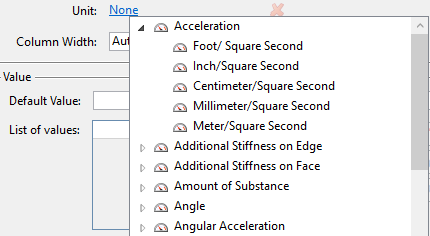
In the ![]() Product Composition window units of measurement are displayed next to values. When inputting a value manually, clicking
Product Composition window units of measurement are displayed next to values. When inputting a value manually, clicking ![]() a unit of measurement invokes the menu, where you can switch to another unit of the same type with or without converting the value and switch to another type of units. When the Weight column is filled manually for records based on fragments, their units are taken from parameters of fragment's document (Document Parameters > Document > 3D > Units > Mass) and do not depend on column properties.
a unit of measurement invokes the menu, where you can switch to another unit of the same type with or without converting the value and switch to another type of units. When the Weight column is filled manually for records based on fragments, their units are taken from parameters of fragment's document (Document Parameters > Document > 3D > Units > Mass) and do not depend on column properties.
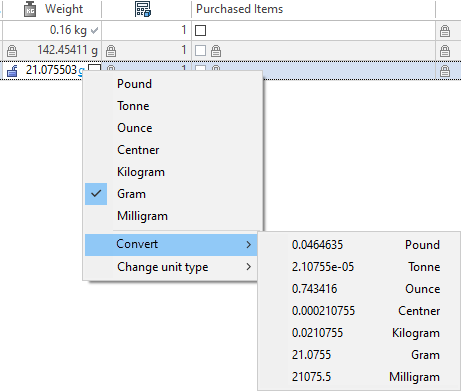
Column Width
Parameter sets column width in pixels in the ![]() Product composition window by default.
Product composition window by default.
Changing width in ![]() parameters of existing compositions has no effect. Changing width in
parameters of existing compositions has no effect. Changing width in ![]() parameters of product composition type affects only compositions created after applying the change.
parameters of product composition type affects only compositions created after applying the change.
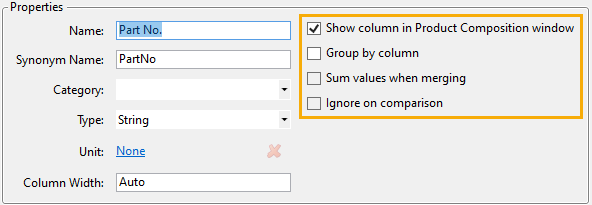
Show column in Product Composition window
If the checkbox is enabled, the column is shown in the ![]() Product Composition window, when no representations are applied
Product Composition window, when no representations are applied ![]() .
.
Group by column
If the checkbox is enabled, all records with the same value in this column will be merged into groups in the ![]() Product Composition window, when no representations are applied
Product Composition window, when no representations are applied ![]() .
.
Sum values when merging
If the checkbox is enabled, the values in this column will be summed for the merged records. For example the values in Quantity column will be summed, if there are similar parts in the assembly. Summed values are highlighted in green color.
Upon enabling this checkbox, the Ignore on comparison checkbox gets replaced by the drop-down list of summation methods, separators input box and Consider Hierarchy when Summing checkbox.
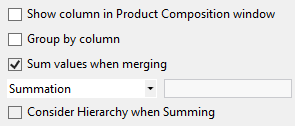
Following summation methods are available:
•Summation
The result is the arithmetic sum.
•Concatenate strings
The result is the sequence of values.
•Concatenate unique strings
The result is the sequence of values, without duplicated values.
•Concatenate Unique Values with Quantity
The result is the sequence of values. For duplicated values a number of duplications will be added before the value..
In all methods, except Summation, the results are combined into a single string. Value can be separated within the string by symbols typed into the input box located to the right of the summation methods drop-down list.
Concatenate string, Concatenate unique strings and Concatenate Unique Values with Quantity methods are applicable to text strings only.
Consider Hierarchy when Summing
The checkbox is only available when using the arithmetic summation. If the checkbox is enabled, then the sum of values is multiplied by the number of parent records.
Considering hierarchy doesn't consider records belonging to other parents. In the example below the Total Quantity column contains number of records with considering hierarchy. Part 1 is included into Sub-Assy 1 three times, while the Sub-Assy 1 is included into the top level assembly two times. In result, the total quantity for Part 1 is 3*2=6 pc. Instances of Part 1 belonging to Sub-Assy 2 (5. pc.) and to the top level assembly (1 pc.) are counted separately.
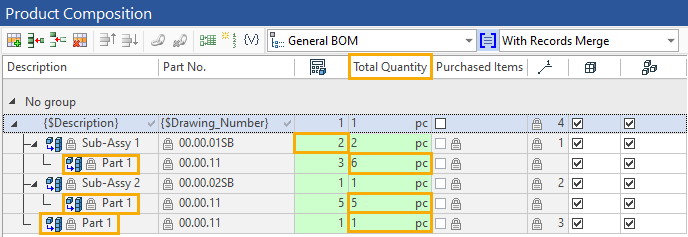
Ignore on comparison
When the checkbox is enabled, the content of the column will be not taken into account when the product composition records are compared. I.e. if there are several records, which parameters differ only in this column, these records can be merged - the column will not affect merging.
The group contains following parameters:

Default value
The entered value will be automatically set in the column data cell for each new manually created record.
List of values
Allows to create preset list of values for a column. When you enter text into the string it will be added to the list after pressing <Enter>. After that you may enter another string to the list. Strings can be selected in the list using ![]() . You can
. You can ![]() Delete <Del> selected string or move it
Delete <Del> selected string or move it ![]() Up and
Up and ![]() Down the list, using buttons located to the right.
Down the list, using buttons located to the right.
If list exists for a column it will be available for selection in the Product composition window, upon pressing the ![]() button located in the right side of the cell..
button located in the right side of the cell..

This group of parameters allows to customize format of numerical values in columns with String and Real data types. The group is not displayed, when using other data types. It contains following parameters:
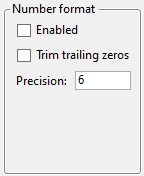
Enabled
This checkbox is available only for columns with String data type. If the checkbox is disabled, then number format parameters are not applied, regardless of status of other controls in this group.
Upon enabling number format for string data, only the strings starting with a number are recognized as numbers. First point after the start of the string is considered a decimal symbol. Any other symbols, as well as subsequent points and numbers separated form the starting ones by other symbols are omitted.
Trim trailing zeros
If the checkbox is enabled, then zeroes are not displayed at the end of a number. For string data omitted zeroes are still kept in parameters of record, so the checkbox only affects display numbers in the main section of the ![]() Product Composition window.
Product Composition window.
Precision
Values will be rounded to the specified number of symbols after the decimal symbol. Regardless of the data type, the rounded value is only displayed in the main section of the ![]() Product Composition window, while the initial value is kept in parameters of record.
Product Composition window, while the initial value is kept in parameters of record.
Data can be entered in the column cell manually or automatically. You can select data assignment method from the drop-down list of the Data Assignment group.
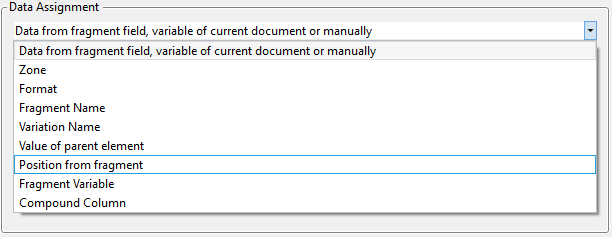
•Data from fragment field, variable of current document or variable
This data source is selected by default. If the name of the current column coincides with the name of the column of the fragment document's product composition, then the content of the latter column will be used for filling the former column. Alternatively, you can type in via keyboard an arbitrary value, a name of a variable or an expression.
Names of variables and expressions should be put into curvy braces {}, otherwise they will be handled as an arbitrary set of symbols. Moreover, you can use the checkbox, which invokes the expression constructor.
When using this data assignment method, cells of the current column in the ![]() Product Composition window will have the
Product Composition window will have the ![]() Automatic field status by default. In order to enter an arbitrary value, a name of a variable or an expression, you have to switch cell status to
Automatic field status by default. In order to enter an arbitrary value, a name of a variable or an expression, you have to switch cell status to ![]() Filed is filled by user. Switching the status is performed by clicking
Filed is filled by user. Switching the status is performed by clicking ![]() icon of the current status..
icon of the current status..
When using other data assignment methods, cells of the current column in the ![]() Product Composition window will have the
Product Composition window will have the ![]() Field is filled by generator status by default. If necessary, you can switch status of such cell in the same way, in order to type in a value manually.
Field is filled by generator status by default. If necessary, you can switch status of such cell in the same way, in order to type in a value manually.
Data assignment methods available in the column properties are designed primarily for product compositions, which use the <Fragment Product Composition> data source. When using other data sources, you can assign data sources to columns using the lower section of the Sources tab of the ![]() Product Composition Parameters and
Product Composition Parameters and ![]() Product Composition Types windows. Selected data source may differ from selected data assignment method. Switching between applying a column's data source and data assignment method is performed via the special checkbox.
Product Composition Types windows. Selected data source may differ from selected data assignment method. Switching between applying a column's data source and data assignment method is performed via the special checkbox.
•Zone
If a record is based on a fragment, the column will be automatically filled with a number of assembly drawing's zone, which contains the fragment. The method of zone detection depends on the value of the Detect zone by parameter.
•Format
Format of the fragment drawing (if the fragment is a part) or fragment BoM (if the fragment is an assembly). Upon selecting this data assignment method, the Collect formats of all document pages checkbox appears below. If the checkbox is enabled, then list of all used formats will be displayed for multi-page documents. If the checkbox is enabled, then only the format of the first page is displayed.

![]()
•Fragment Name
Upon selecting this data assignment method, the Use the top operation in the chain checkbox appears below.
If the checkbox is disabled, then the columns contains name and folder of fragment file
If the checkbox is enabled, then the content of the column depends on whether a linked 3D fragment was supplemented in assembly. For supplemented fragments the column contains the name of the last 3D modeling operation applied to fragment. For non-supplemented fragments the column contains the displayed name of fragment. A column with this option enabled can be used for in order to prevent merging of records with different supplements.

•Variation Name
Name of the fragment variation that is used in assembly. You can specify the variation name in Model Configurations and Variations command.
•Value of parent element
Upon selecting this data assignment method, another drop-down list appears below. There you should select a name of another Column. In result, when records have hierarchy, the values of the selected column for parent records will be used as values of the current column for children records.


•Position from fragment
If a sub-assembly is included into the product composition of the current assembly with embedded elements, then, upon selecting selecting this data assignment method, the content of the column for such embedded elements depends on the status of the Don’t use the “Positon” system column of the current document checkbox. If the checkbox is disabled, records that have positions in the current document will use such positions, while records that don’t have positions in the current document will use positions from fragments. If the checkbox is enabled, the column uses only positions from fragments.

•Fragment Variable
Fragment variable value will be used as value. Upon selecting this data assignment method an input box appears below, where you need to type in a fragment Variable name. If there is no such variable in the fragment document, the value will be empty. Any variable can be accessed, no matter if it's external or not.

•Compound Column
Allows you to compose the value using values of other columns. Data can be taken from any other columns. Mathematical and logical operators can be applied to the columns. Detailed information is available in the Compound Columns of Product Composition section.

Topics in this section:
•Compound Columns of Product Composition
•Service Columns of Product Composition
See Also: